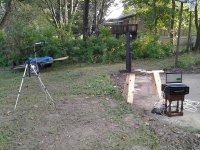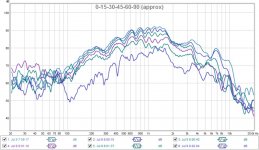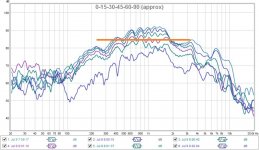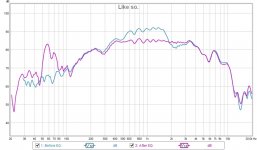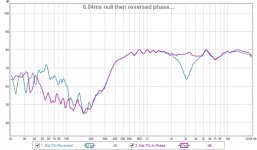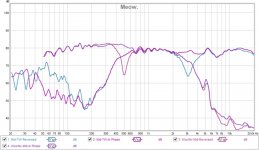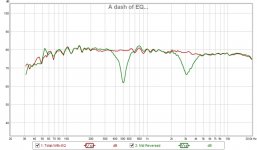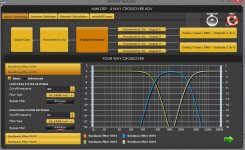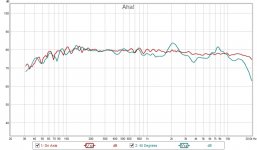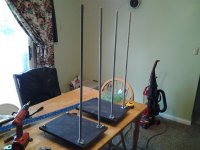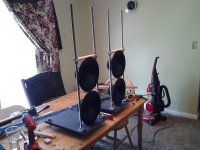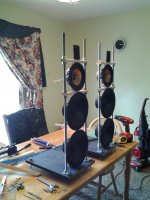I don't see anything wrong with it. Personally, I'd xo lower like below 200hz ... add in a 6db low shelving filter around 340hz and play with the gain to suit. I know some guys like the 6db low cutoff but on some recordings it seems to lack bass presents. You could experiment with another alternative, being your target cutoff with a 12db slope and a Q of 1.0-1.2 Some recordings like this ... at least to my ear.
oops, ... my bass recommendation is coming from a naked woofer ... might be helpful still?
oops, ... my bass recommendation is coming from a naked woofer ... might be helpful still?
Last edited:
I don't see anything wrong with it. Personally, I'd xo lower like below 200hz ... add in a 6db low shelving filter around 340hz and play with the gain to suit. I know some guys like the 6db low cutoff but on some recordings it seems to lack bass presents. You could experiment with another alternative, being your target cutoff with a 12db slope and a Q of 1.0-1.2 Some recordings like this ... at least to my ear.
oops, ... my bass recommendation is coming from a naked woofer ... might be helpful still?
I suppose I can go into my reasoning with the XO points a bit. Primarily, I wanted to go fairly high to increase power handling a bit, and at the same time, stay below where beaming became an issue. Now, in learning a bit more about open baffle each day, I've essentially just been resetting the MiniDSP to defaults and starting over every time, because I really do want to get it right.
The major issue for me right now is indoor vs outdoor measurements. When I measure the drivers outside, close-mic or far (even as far as 2m) I get driver responses that are actually really well-behaved within the bands that I'd like them to work in. When I plug in the crossover values, it ends up needing very little LF boosting at all. Phase looks reasonable. Some very mild EQ is all it takes, and bam, it's spot on.
So, I'm like
Then, I bring it back inside, put the mic in the MLP, copy the config to the other speaker and run a sweep in the room.
And I'm like
It looks like the Himalayas! So, I try to EQ and fuss with it..and I can fix it a little...I can make it sound "listenable" and even quite good, but something is just not right.
So, the eprom on the MiniDSP is empty at the moment, except for what I did last night messing with the woofer. The measurement on the last page I did indoors, with the speaker sitting where it normally does, but with the mic about 5cm from the baffle between the two woofers. I tried implementing LT, however that just turned the output stage on the MiniDSP into a chainsaw - and 90% of the boosted frequencies (and associated cone flapping) were all lower than I'm going to cross these over to the subs anyway.
I'm going to try and see if I can get the response and the phase integration at the XO points to look "correct" for at least the woofer and mid this morning.
Edit: This is my plan for today.
Last edited:
DrDyna,
what you want to get right (and straight) is the direct response. That is without the comb filter "Himalaya" introduced by the in-room reflections. You can do that for the midrange and tweeter sections by measuring outdoor, or by gating any indoor IR measurement to the region below the first reflection. Keep the mic distance from the driver at least three times the baffle width to get the dipole rolloff right. This applies to all measurements, regardless of angle.
When measuring the woofers, the floor and room mode influence has to be part of the equation. You want to get it right in the room at your listening position. No gating. Don't try to equalise any deep and small notches. Only peaks or wide troughs. And keep in mind that your ears are not very sensitive for SPL differences down low. It doesn't make any sense to measure a dipole woofer SPL from 5 cm distance. Looks nice for sure, but is meaningless.
Many people prefer to raise dipole SPL below 100 Hz to get some (bit of) bass punch. But please forget about the textbook LT.
Good luck!
what you want to get right (and straight) is the direct response. That is without the comb filter "Himalaya" introduced by the in-room reflections. You can do that for the midrange and tweeter sections by measuring outdoor, or by gating any indoor IR measurement to the region below the first reflection. Keep the mic distance from the driver at least three times the baffle width to get the dipole rolloff right. This applies to all measurements, regardless of angle.
When measuring the woofers, the floor and room mode influence has to be part of the equation. You want to get it right in the room at your listening position. No gating. Don't try to equalise any deep and small notches. Only peaks or wide troughs. And keep in mind that your ears are not very sensitive for SPL differences down low. It doesn't make any sense to measure a dipole woofer SPL from 5 cm distance. Looks nice for sure, but is meaningless.
Many people prefer to raise dipole SPL below 100 Hz to get some (bit of) bass punch. But please forget about the textbook LT.
Good luck!
Thanks Rudolf.
I'm going to stay outside today until I get this right, or it rains.
Anyone have any comments about this measuring setup?
To start: Midrange, no filters, checking dipole behaviour. Looks good to 3k? Or am I reading this wrong?
Edit2: This is really my question...If I set this as the target, I don't really have to deal with 6db rolloff...or will that result in terrible things happening?
Edit3: Example attached.
I'm going to stay outside today until I get this right, or it rains.
Anyone have any comments about this measuring setup?
To start: Midrange, no filters, checking dipole behaviour. Looks good to 3k? Or am I reading this wrong?
Edit2: This is really my question...If I set this as the target, I don't really have to deal with 6db rolloff...or will that result in terrible things happening?
Edit3: Example attached.
Attachments
Last edited:
On the right track?
Edit: Playing with EQ.
Edit2: I'm going to chill out here in the back yard with my coffee just in case anyone has any suggestions that would be better out here.
It's a nice day to be outside! So far, the bugs have left me alone!
Edit: Playing with EQ.
Edit2: I'm going to chill out here in the back yard with my coffee just in case anyone has any suggestions that would be better out here.
It's a nice day to be outside! So far, the bugs have left me alone!
Attachments
Last edited:
This is better than what I doAnyone have any comments about this measuring setup?
It is tempting to do so. But it would be less than ideal:Edit2: This is really my question...If I set this as the target, I don't really have to deal with 6db rolloff...or will that result in terrible things happening?
Look at 1 kHz. You see the 45° SPL about 6.5 dB below the 0° level. Now move to 2 kHz. The difference between 0° and 45° is reduced to 2 dB. Go to 3 kHz and the relationship is the same again as at 1 kHz.
If you would translate that into a polar diagram, you would see how the off axis response around 45° gets increasingly wider/louder from 1-2 kHz and gets muted to the original level from 2-3 kHz. It is as if you had some additional drivers directed 45° outside, blasting away only from 1-3 kHz.
It is the classic example why you don't want to use dipoles above the dipole peak.
Yeah, those are the diagrams I wanted to see!On the right track?
Edit2: I'm going to chill out here in the back yard with my coffee just in case anyone has any suggestions that would be better out here.
The dips for the inverted case are deep enough and the single driver curves (you just show the midrange) are 6 dB below the summed curve at the dip center frequency. For my taste there is nothing more to wish for a good LR crossovers.
Would be interesting to see your minDSP crossover window for this.
Yeah, those are the diagrams I wanted to see!
The dips for the inverted case are deep enough and the single driver curves (you just show the midrange) are 6 dB below the summed curve at the dip center frequency. For my taste there is nothing more to wish for a good LR crossovers.
Would be interesting to see your minDSP crossover window for this.
Here you are sir!
Edit: I think I understand the off axis peak now. This means the baffle should be thinner to use this crossover frequency, I assume.
Edit2: Why do I have a feeling I'm going to end up with a copy of the nao-note baffle? LOL.
Attachments
Last edited:
I'm amazed that your symmetrical crossover pattern still works.Here you are sir!
Yes, exactly. If you mean narrower instead of thinner.Edit: I think I understand the off axis peak now. This means the baffle should be thinner to use this crossover frequency, I assume.
Same applies for the 6-7 kHz peak, but we can't do anything about that without destroying the Neo3.
If you have a large driver on a rather narrow baffle (less than twice the cone diameter), the dipole dip doesn't show prominently. But we can see, where it would start and stop:Is the dipole peak on the midrange what's happening around 1.8k?
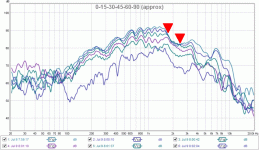
The red triangles show where the 0-30° lines merge and diverge again. These are the lower and upper border of the dipole dip. It is centered at 2 kHz. The official dipole peak is one octave below that: 1 kHz. That's were your response should take a dive - at the latest.
I'm amazed that your symmetrical crossover pattern still works.
Yes, exactly. If you mean narrower instead of thinner.May be you need to use the midrange driver without the baffle too?
Same applies for the 6-7 kHz peak, but we can't do anything about that without destroying the Neo3.
If you have a large driver on a rather narrow baffle (less than twice the cone diameter), the dipole dip doesn't show prominently. But we can see, where it would start and stop:
View attachment 359075
The red triangles show where the 0-30° lines merge and diverge again. These are the lower and upper border of the dipole dip. It is centered at 2 kHz.
Right, narrower is what I meant. Sorry the heat outside was starting to get to me!
The official dipole peak is one octave below that: 1 kHz. That's were your response should take a dive - at the latest.
On this particular baffle though, right? A more narrow baffle would be able to have the mid-tweeter XO higher because the peak is moved up (or almost gone if the drivers are operated nude?)
Maybe I should abandon the baffle completely and go with the idea of just suspending the drivers naked.
Is it still the Eton 7/360 for midrange? That's a rather large driver for midrange already. I am afraid you need to use it without baffle to allow for a 2-2.5 kHz crossover to the Neo3. That's at least what Edge tells me. The Eton will still be loud enough for the nude Neo3.Maybe I should abandon the baffle completely and go with the idea of just suspending the drivers naked.
Rudolf
Is it still the Eton 7/360 for midrange? That's a rather large driver for midrange already. I am afraid you need to use it without baffle to allow for a 2-2.5 kHz crossover to the Neo3. That's at least what Edge tells me. The Eton will still be loud enough for the nude Neo3.
Rudolf
Cool, thanks again Rudolf. I think I have enough information to come up with something better, perhaps something like StigErik has done, just without the 21" monster H frames
Thanks for all your help, I'll post something again once I figure out what I'm going to do.
Edit: I have some Vifa SC14SG-49 at my disposal as well, those might be more well suited.
Last edited:
Hot rodding?
There is a (German) thread about my dipole efforts without baffle that I called Swinger Club
There is a (German) thread about my dipole efforts without baffle that I called Swinger Club
Hot rodding?
There is a (German) thread about my dipole efforts without baffle that I called Swinger Club
Bwahahahah!
I'll have to read that thread.
- Status
- This old topic is closed. If you want to reopen this topic, contact a moderator using the "Report Post" button.
- Home
- Loudspeakers
- Multi-Way
- Starting an Active Open Baffle design.
